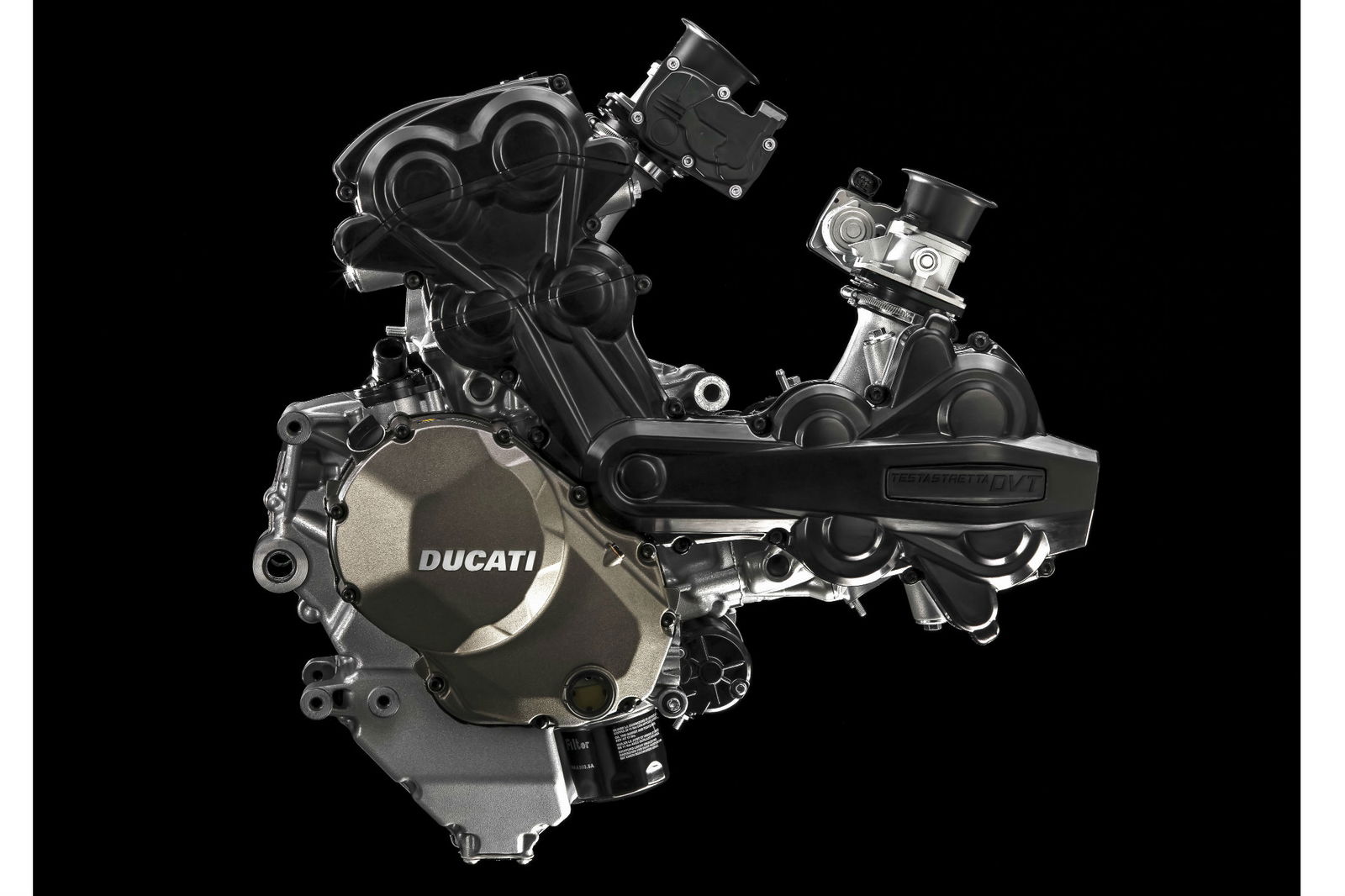New Ducati Multistrada details revealed
Variable valve timing means 160hp for updated performance-adventure bike


DUCATI has just unveiled details of the new 2015 Multistrada with variable valve timing.
The firm has followed up its enigmatic release of last week which said 'DVT is coming' by issuing full details of the new engine.
We were right - DVT isn't a reference to deep vein thrombosis, but stands for 'Desmodromic Variable Timing'.
We're going out on a limb a little by saying it's the Multistrada that's getting DVT, because nowhere in the latest release is the high-performance adventure model actually named.
But given the engine described is a 1198cc Testastretta 11° V-twin, as used by the Multistrada, and an updated version of the model is due to be unveiled at the Milan motorcycle show next month, it's a robust limb.
DVT boosts power to 160hp and torque to 100lbft, up from the current version's 150hp and 91.8lbft.
Ducati's release said:
'Ducati Testastretta DVT (Desmodromic Variable Timing)
Ducati presents the first motorcycle engine with variable timing of both the intake and exhaust camshafts.
Named Ducati Testastretta DVT, Desmodromic Variable Timing, Ducati's new Desmodromic engine
is the first in the world with variable timing on both inlet and exhaust camshafts, leading the way for
a whole new generation of such engines. The innovative, new design overcomes an engineering gap in
current production motorcycle engines and underlines Ducati's strength in developing ground-breaking
engine and motorcycle technologies.
The variable timing system is able to continuously adjust valve timing, by acting independently on both the
intake and exhaust camshafts. The system optimises engine performance throughout the rev range and in
any operating condition, to guarantee the highest power, smooth delivery, muscular torque at low rpm
and reduced fuel consumption. With full Euro 4 compliance, DVT sets a new standard in the combination
of power, delivery and usability of motorcycle engines.
Ducati Testastretta DVT engine characteristics
? Brand-new DVT (Desmodromic Variable Timing) system
? Bore 106 mm, stroke 67.9 mm
? Capacity 1,198 cm³
? Max power 160 HP at 9,500 rpm
? Max torque 136 Nm at 7,500 rpm
? Desmodromic distribution
? Dual Spark (DS) ignition
? Anti-knock sensor
? Euro 4 compliant
New generation
By independently adjusting both the timing of the camshaft controlling intake valves and the timing of
the camshaft controlling exhaust valves, the Ducati Testastretta DVT engine optimises high rpm
performance for maximum power, while at medium and low rpm, it ensures smooth operation, fluid power
delivery and high torque. This means that the vehicle's engine will adapt its characteristics according to rpm
values, while always ensuring compliance with exhaust emission standards and keeping fuel consumption
low.
When a new engine is designed, one of the most critical parameters to determine its 'character' is the
amount of intake and exhaust valve overlap. The overlap angle is defined as the interval of crankshaft
rotation, expressed in degrees, during which both the intake and exhaust valves are open at the same time.
This overlap occurs between the end of the exhaust stroke and the start of the intake stroke and is normally
a single value that does not change. However, the Testastretta DVT is not limited by a fixed valve overlap
angle.
Instead, the Ducati Testastretta DVT’s overlap angles can change, thanks to the introduction of the DVT
(Desmodromic Variable Timing) system: a valve timing adjuster fitted to the end of each of the two
camshafts per cylinder head. The DVT system consists of an external housing, rigidly connected to the
cam belt pulley, and an internal mechanism which is connected to the camshaft and can independently
rotate inside the housing. This rotation of the internal mechanism, either in advance or in delay with respect
to the housing, is precisely controlled by varying the oil pressure in special chambers of the mechanism. The oil pressure is adjusted by dedicated valves and the timing of each cam is dynamically controlled by a
sensor located in the cam covers.
Desmo attraction
The Ducati Testastretta DVT engine uses the unique valvetrain that made the Bologna-based Italian
manufacturer a world-famous name. Thanks to this unique system, the intake and exhaust valves are
closed mechanically and with the same level of accuracy as they are opened. The term Desmodromic
derives from the Greek words “desmos=link” and “dromos=stroke, travel”; in mechanical engineering
terms, it refers to mechanisms designed to actuate valves both in the opening direction and in the closing
direction.
This system, used in all Ducati models, has also been extremely successful in Ducati Corse World
Superbike and Desmosedici MotoGP motorcycles.
In the development of the DVT, the Desmodromic valvetrain represents a major advantage over a
traditional spring based timing system; the actuation of the valves at low engine speed requires less force,
not having to compress the valve springs, this allowed Ducati to limit the size of each cam phaser with
obvious benefits in terms of lightweight construction and compactness for a perfect engine integration.
Ever-present strong torque
With its 106 mm bore and 67.9 mm stroke for a total capacity of 1,198 cm³, the newborn Ducati
Testastretta DVT engine produces a maximum power of 160 HP at 9,500 rpm, and a torque up to 136 Nm
at 7,500 rpm with a perfectly linear delivery curve. The torque is already 80 Nm at a low-range value of
3,500 rpm, and it remains consistently over 100 Nm between 5,750 and 9,500 rpm.
Despite an increase in power, however, the DVT system has a positive impact on fuel efficiency, with
an average 8% reduction in fuel consumption compared to the previous non-variable configuration.
Ducati's permanent research and development efforts applied to injection systems have repositioned
the fuel injectors to target their spray directly onto the rear of the hot intake valve, instead of the colder
surface of the intake port wall. The resulting enhanced fuel vapourisation improves combustion efficiency
and ensures a smoother delivery.
The Testastretta DVT is equipped with a Dual Spark (DS) system that uses two spark plugs per cylinder
head, providing a twin flame-front that ensures complete combustion across a very short period of time.
Each spark plug is managed independently, to optimise efficiency throughout the rev range and in all
conditions of use. An anti-knock sensor ensures safe engine operation even while using lower octane fuel
or in situations potentially detrimental to combustion efficiency, e.g. at high altitude.
In order to achieve a smoother cycle-to-cycle engine operation, Ducati has used a secondary air system
similar to that developed for extremely high-performance engines. This optimizes combustion without
increasing emissions, by completing the oxidisation of unburned hydrocarbonsto reduce HC and CO levels.
Suitable for any condition
Thanks to all these characteristics, the Ducati Testastretta DVT sets new standards for Ducati twincylinder
power units and introduces new, revolutionary parameters to achieve the best possible balance
among maximum power, smooth delivery, low-rpm torque, low fuel consumption and reduced emissions,
thus standing out as the most technologically advanced Desmodromic twin-cylinder engine on the planet.
The Ducati Testastretta DVT system does not affect the valve clearance adjustment schedule, and in fact
requires major services only at ownership-friendly 30,000 km intervals. This engine can be used in a wide
variety of conditions and locations, while always delivering top performance and exceptional userfriendliness,
safety and sheer excitement.'











